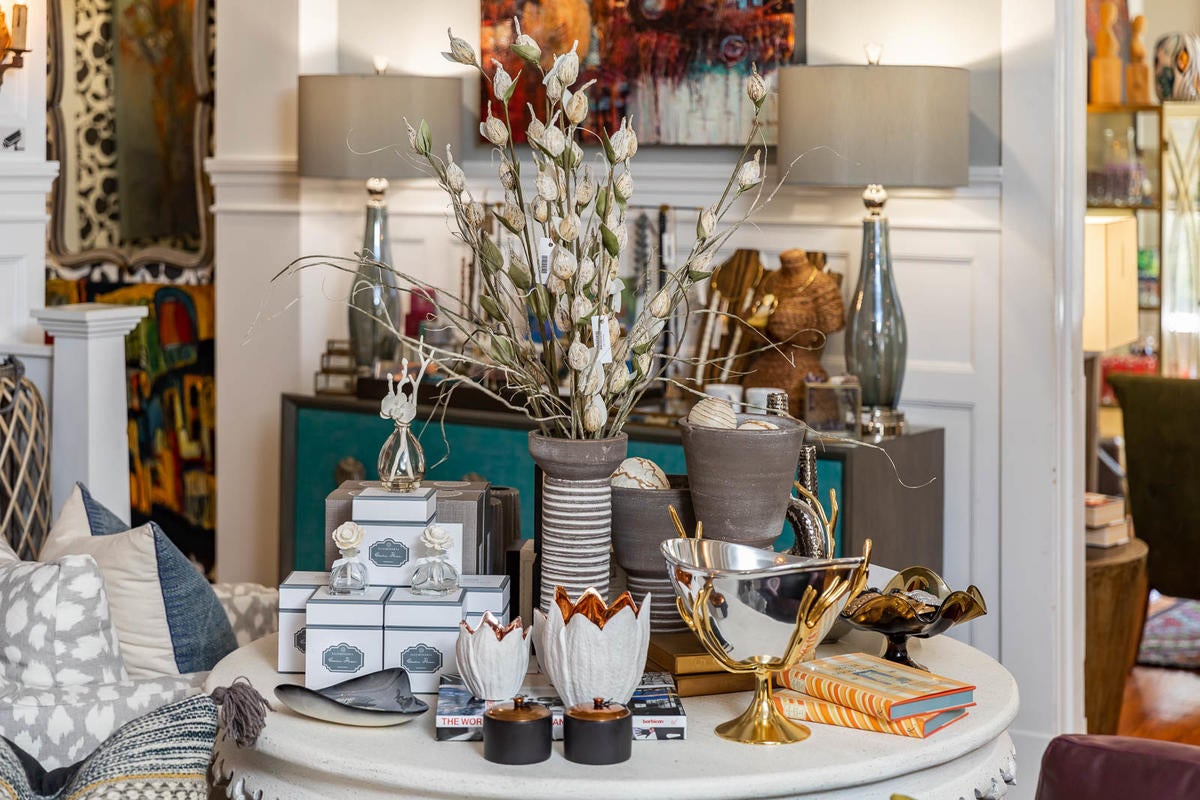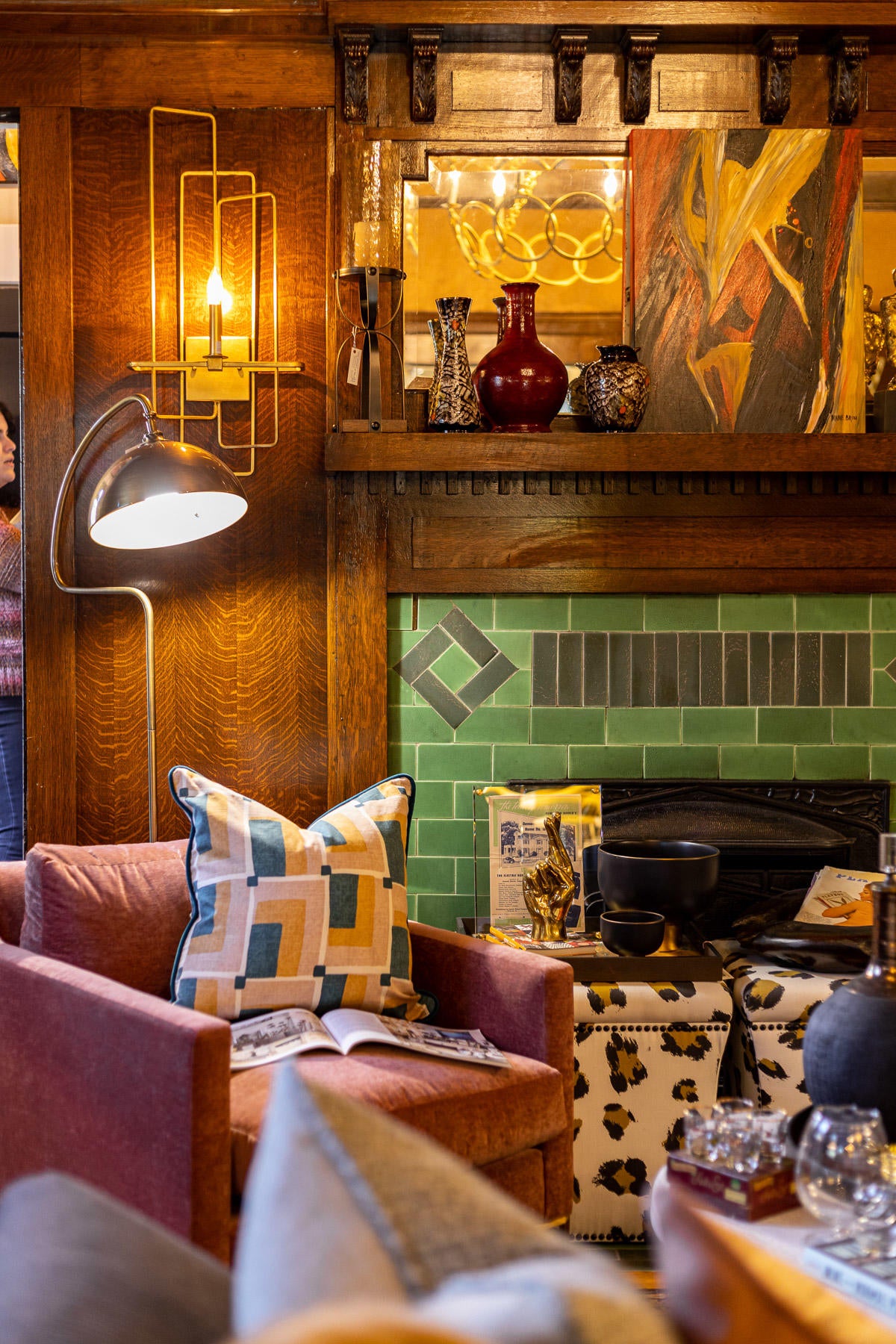In Business of Home’s series Shop Talk, we chat with owners of home furnishings stores across the country to hear about their hard-won lessons and their challenges, big and small—and to ask what they see for the future of small industry businesses like theirs.
This week, Cheryl Kees Clendenon, who runs the full-service design firm In Detail Interiors, discusses her store, 1514 Home, which is tucked inside a 1910 bungalow in Pensacola, Florida. “I’ve always been a big fan of studying consumer behavior,” says Kees Clendenon, who got her start in sales and marketing before pivoting to design. While her first retail venture was 15 years ago, “It was too much. I didn’t have my design business under control as much as I do now.” She opened 1514 Home in 2009 and stocked it with a museum-like mix of furniture, lighting, accessories and widely sourced vintage barware and memorabilia.
“I look at it like this: We’re a design firm with a retail presence, as opposed to a retailer with a design presence. The design is always going to be top billing,” she says. Still, her decades of retail experience have informed her business philosophy—like a refusal to pander to expectations of the coastal market, and a begrudging acceptance that candle-pouring events are good for the bottom line. “Retail is not for sissies, that’s for sure,” says Kees Clendenon.

What’s the vibe of your store?
I found an old house on the outskirts of downtown in a commercial area, on almost an acre of property. We have three buildings on it: [In addition to the house], we built a small warehouse, and there was an existing carriage house that my husband redid where we have overflow furniture. We style it a little Anthropologie-ish, a little younger. This year, we started a candle studio [inside the carriage house] that my daughter somehow talked me into—this crazy idea, but it’s been really great. People can have parties, like those painting things when people go and paint one thing [together], except it’s unique scents and different kinds of vessels. A candle-pouring event—like this past weekend, she had two bridal showers there.
The building itself is an old 1910 house. We have a resident ghost who lives there. I don’t normally believe in all that hoopla, but I’ll tell you, some weird things happen. It’s very eclectic, very colorful. We have several awesome shops near us, and they all do the RH type of look—white and gray, typical coastal. We went exactly the opposite. Every room is different. We’ve got wallpaper on the ceiling and cool lighting. It is not a place to come if you are a minimalist. We have a ton of vintage barware from all over the country. I collect paper history, from telegrams to brochures and menus—unusual things. A Pan Am flight ticket. Sometimes people come in just to look, because we’ve gotten a reputation for being a museum of sorts. I’m fine with that, because I’m hoping that later on when they get ready to buy a sofa, they’ll remember me.
Who’s your typical customer?
Busy professionals. We get a lot of men in here to shop for their wives or significant others. It originally skewed a little bit older, probably 35 and up, but now I think with the candle studio and my daughter joining the business, it’s gotten a little younger—the newlywed type registering for things. I hate to admit it, but the candle studio has been huge; if she reads this, she’s going to know I think she’s done a great job in making it a destination. We get a lot of people from out of town. I’m amazed at how many people are traveling through or staying for the weekend.
Do you have a favorite vendor?
Vanguard [Furniture] is pretty easy because I got with them when I first started. The rep wouldn’t let me even sell the upholstery at first. He said, “Let’s see how you do with the case goods. We’ll go from there.” I’ll never forget it. He’s since retired, but I’ve had a long relationship with them. It’s a family-owned company, not a corporate entity, so there are real people there that you can talk to when you need to. I think it’s really important, when you’re a designer that has a retail space, that you put more eggs in fewer baskets.
What’s one of your favorite items in the store?
My vintage glass. I love it. I cry a little bit every time we sell a set. Someone comes in and you’ve only had it for a week and they want to buy it—you’re like, “Wait, whoa, what? You don’t understand how this works. I have to get tired of it first before you can buy it.” Everyone rolls their eyes at me and goes, “Cheryl, we are a store. We’re supposed to be selling things, right?” Especially now, good lord. It takes a lot to get things, so you definitely don’t want them to disappear. The thing that breaks my heart is the vintage, because they just don't make it anymore and some of those pieces really speak to me.
Is there any advice you would give yourself if you could go back to opening day?
Don’t open until you’re ready—until all the i’s are dotted and t’s are crossed. We did that the first time; we were not intending to open to the public yet, and then all these little faces were stuck to the windows, people asking to come in. I look back at those pictures and cringe. It’s a first impression, and you don’t get a second time to make that. The second time, when we moved to the new location, I was probably closed for a good six months, getting everything ready and having a big reveal, just like we do with a client. I hate, hate, hate doing partial installs.

And then all the damn paperwork. Someone asked me that not long ago, like, “What’s your least favorite thing?” It’s the paperwork, the 1099s, the sales tax, the unemployment tax, the quarterly this and the monthly that. I have one person in charge of all that who has to remind me to do it every month.
If the paperwork is your biggest everyday challenge, what’s the biggest existential challenge?
Finding the right people. Right now, we’re very blessed with a really great team, but we’re growing, so we’re always on the lookout. We’re in a smaller area, so we don’t have as much of a pool. Staffing is probably the biggest existential challenge for a lot of us right now. It’s not always easy to find somebody that really has the work ethic—that’s the thing that seems to be suffering the most these days: people not wanting to start in the mailroom, so to speak, and move on up.
A lot of designers are certain personality types—strong-willed or opinionated—and I think no one prepared me for managing people or knowing how to get the most out of people. I had to learn that on my own, sometimes the hard way.
What is something you wish more customers understood about the business?
I don’t know that people really understand what kind of overhead goes into running a retail store. Even now, people are trying to negotiate on a sofa. I’m like, “Are you kidding me? I don’t even want to sell that sofa because it’s going to take me a year to get another one in.” I’m sure as heck not going to be discounting it.
Because we’re in a smaller city, people constantly want donations. Yet they won’t even come into your store! I will give them something for their auction or whatever. I don’t care what it is—I’m very generous that way. But you know what? I want you to at least walk in, not just call or send a letter. People don’t realize that this is a real person running this. The buck stops here—I’m the sole owner of the company. I have to come up with $50,000 a month before I make a penny.
So are people like, “I’m doing a charity auction—give me a couch”?
It’s more like a basket of things, or a pre-consult. We’re just too busy for that sort of thing. I want people to come in because they want to come in, but when people ask us to do something for their pet charity, or donate time for it, and they don’t come in, it really offends me. A lot of people will message you on Facebook or Instagram: “Cheryl, I love your store. It’s so great.” You’ve never been in my store!
How do you convey to customers that what you’re offering is perhaps more worthwhile than the cheap stuff they see on the internet?
I really don’t fight the internet. I feel like if you have to fight the internet, you’re doing something wrong. You have to make [your store] a brand—you really do. And make it cool. You don’t cheap out on the bags. You don’t cheap out on the tissue paper. You don’t cheap out on wrapping. We have people call and say, “I’ve seen this online—can you match that?” The [staff] all have a set thing that they explain to people, on why we can’t and won’t do that.
What’s a Pensacola-specific challenge?
Being in the South—because really, Pensacola is in the South, more South than it is Florida—there’s a lot of pressure to conform. People like what they see, so when they see magazines all over the place [showing] gray and white, they’re going to want gray and white. We’ve made a thing of not conforming and people respect that. It’s OK to dare to be different and go against the grain. And I think probably in a city like New York or Los Angeles, it’s a little easier to do that. But in smaller towns, I find that a lot of the designers will feel like they have to conform. It’s probably one of the most common denominators in small to midsize cities, where they feel like they have to pander to what everybody wants, as opposed to bringing something new to the marketplace. People think it’s coastal—you’re going to do palm trees and white and gray, shabby chic and Restoration Hardware and all that crap. We’re exactly the opposite.
What’s the future of small businesses like yours?
We’re uniquely positioned for smaller boutique businesses to make a resurgence. You’re now seeing a lot of problems with the big-box stores, and I think the unique and smaller boutiques—as long as they are very light on their feet, not into serious overhead—I think that that’s where it’s at. People are being more mindful of shopping local and shopping small. It’s been a movement for a while, of course, but with COVID, I feel that it’s going to be more like that. Our sales have gone up, and not just because of the supply chain break.
I think it just takes an inordinate amount of time for people to find you, especially when you’re like us and don’t advertise a lot because we don’t have time. We just do basic things, Google AdWords and occasional ads in a paper or local magazine, but overall, it’s word-of-mouth. Once you have that, it’s a very select customer, and they’re very loyal to you. Overall, the smaller boutique—having a very branded message and being about something, having something to hang your hat on, that makes you unique. And different is a good thing.
Homepage photo: Kees Clendenon (center) with staff members Libby Kees (left) and Liz Lapan (right) | Photo courtesy of 1514 Home



























